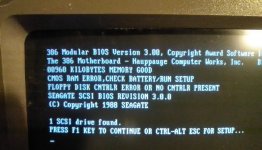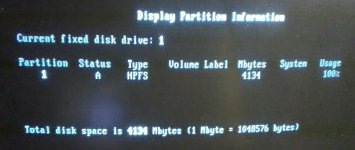I have just tested a couple of Seagate ST-01 SCSI cards. I remember using one of them with an ST-157N drive years ago - but I don't remember in what system.
My first test was in an XT clone board (a modern one; integrated chip-set, V20, 256kB RAM). I got this result, no matter what working drive I attached:

Then I tried moving the card to a 386 board. Much better result:

I finally tried a more "classic" XT clone, using a standard 8088 and a full 640kB RAM. Same result as the other XT board. Adding an extra 256kB to the "modern" board also did not change anything. Does the Seagate board with a recent BIOS need a 286 to work?
I tried BIOS version 3.0, 3.2 and 3.3.2. The board came with 3.0 originally. The 3.3.2 version supports more devices, and has more verbose output. But none of the versions worked in my XT boards...
Just for fun, I tried connecting a 4.3GB wide SCSI-2 drive. That almost worked:

The existing partition was recognised, I could format the drive and copy some files, but I got random hangs. That could just be the cable I used though. It was made for connecting a narrow drive to a wide controller - not the other way around.
My first test was in an XT clone board (a modern one; integrated chip-set, V20, 256kB RAM). I got this result, no matter what working drive I attached:

Then I tried moving the card to a 386 board. Much better result:

I finally tried a more "classic" XT clone, using a standard 8088 and a full 640kB RAM. Same result as the other XT board. Adding an extra 256kB to the "modern" board also did not change anything. Does the Seagate board with a recent BIOS need a 286 to work?
I tried BIOS version 3.0, 3.2 and 3.3.2. The board came with 3.0 originally. The 3.3.2 version supports more devices, and has more verbose output. But none of the versions worked in my XT boards...
Just for fun, I tried connecting a 4.3GB wide SCSI-2 drive. That almost worked:

The existing partition was recognised, I could format the drive and copy some files, but I got random hangs. That could just be the cable I used though. It was made for connecting a narrow drive to a wide controller - not the other way around.
